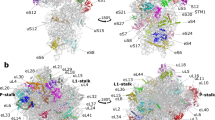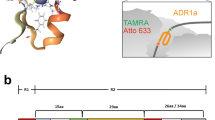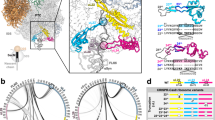Abstract
Although tertiary folding of whole protein domains is prohibited by the cramped dimensions of the ribosomal tunnel, dynamic tertiary interactions may permit folding of small elementary units within the tunnel. To probe this possibility, we used a β-hairpin and an α-helical hairpin from the cytosolic N terminus of a voltage-gated potassium channel and determined a probability of folding for each at defined locations inside and outside the tunnel. Minimalist tertiary structures can form near the exit port of the tunnel, a region that provides an entropic window for initial exploration of local peptide conformations. Tertiary subdomains of the nascent peptide fold sequentially, but not independently, during translation. These studies offer an approach for diagnosing the molecular basis for folding defects that lead to protein malfunction and provide insight into the role of the ribosome during early potassium channel biogenesis.
This is a preview of subscription content, access via your institution
Access options
Subscribe to this journal
Receive 12 print issues and online access
$189.00 per year
only $15.75 per issue
Buy this article
- Purchase on Springer Link
- Instant access to full article PDF
Prices may be subject to local taxes which are calculated during checkout




Similar content being viewed by others
References
Kosolapov, A., Tu, L., Wang, J. & Deutsch, C. Structure acquisition of the T1 domain of Kv1.3 during biogenesis. Neuron 44, 295–307 (2004).
Lu, J. & Deutsch, C. Secondary structure formation of a transmembrane segment in Kv channels. Biochemistry 44, 8230–8243 (2005).
Tu, L., Wang, J. & Deutsch, C. Biogenesis of the T1–S1 linker of voltage-gated K+ channels. Biochemistry 46, 8075–8084 (2007).
Woolhead, C.A., McCormick, P.J. & Johnson, A.E. Nascent membrane and secretory proteins differ in FRET-detected folding far inside the ribosome and in their exposure to ribosomal proteins. Cell 116, 725–736 (2004).
Mingarro, I., Nilsson, I., Whitley, P. & von Heijne, G. Different conformations of nascent polypeptides during translocation across the ER membrane. BMC Cell Biol. 1, 3 (2000).
Kowarik, M., Kung, S., Martoglio, B. & Helenius, A. Protein folding during cotranslational translocation in the endoplasmic reticulum. Mol. Cell 10, 769–778 (2002).
Hardesty, B. & Kramer, G. Folding of a nascent peptide on the ribosome. Prog. Nucleic Acid Res. Mol. Biol. 66, 41–66 (2001).
Matlack, K.E. & Walter, P. The 70 carboxyl-terminal amino acids of nascent secretory proteins are protected from proteolysis by the ribosome and the protein translocation apparatus of the endoplasmic reticulum membrane. J. Biol. Chem. 270, 6170–6180 (1995).
Ban, N., Nissen, P., Hansen, J., Moore, P.B. & Steitz, T.A. The complete atomic structure of the large ribosomal subunit at 2.4 Å resolution. Science 289, 905–920 (2000).
Nissen, P., Hansen, J., Ban, N., Moore, P.B. & Steitz, T.A. The structural basis of ribosome activity in peptide bond synthesis. Science 289, 920–930 (2000).
Menetret, J.F. et al. The structure of ribosome-channel complexes engaged in protein translocation. Mol. Cell 6, 1219–1232 (2000).
Beckmann, R. et al. Architecture of the protein-conducting channel associated with the translating 80S ribosome. Cell 107, 361–372 (2001).
Minor, D.L. et al. The polar T1 interface is linked to conformational changes that open the voltage-gated potassium channel. Cell 102, 657–670 (2000).
Kreusch, A., Pfaffinger, P.J., Stevens, C.F. & Choe, S. Crystal structure of the tetramerization domain of the Shaker potassium channel. Nature 392, 945–948 (1998).
Li, M., Jan, Y.N. & Jan, L.Y. Specification of subunit assembly by the hydrophilic amino-terminal domain of the Shaker potassium channels. Science 257, 1225–1230 (1992).
Shen, N.V., Chen, X., Boyer, M.M. & Pfaffinger, P. Deletion analysis of K+ channel assembly. Neuron 11, 67–76 (1993).
Xu, J., Yu, W., Jan, J.N., Jan, L. & Li, M. Assembly of voltage-gated potassium channels. Conserved hydrophilic motifs determine subfamily-specific interactions between the α-subunits. J. Biol. Chem. 270, 24761–24768 (1995).
Gu, C., Jan, Y.N. & Jan, L.Y. A conserved domain in axonal targeting of Kv1 (Shaker) voltage-gated potassium channels. Science 301, 646–649 (2003).
Cushman, S.J. et al. Voltage dependent activation of potassium channels is coupled to T1 domain structure. Nat. Struct. Biol. 7, 403–407 (2000).
Kurata, H.T. et al. Amino-terminal determinants of U-type inactivation of voltage-gated K+ channels. J. Biol. Chem. 277, 29045–29053 (2002).
Wang, G. & Covarrubias, M. Voltage-dependent gating rearrangements in the intracellular T1–T1 interface of a K+ channel. J. Gen. Physiol. 127, 391–400 (2006).
Lu, J., Robinson, J.M., Edwards, D. & Deutsch, C. T1–T1 interactions occur in ER membranes while nascent Kv peptides are still attached to ribosomes. Biochemistry 40, 10934–10946 (2001).
Kosolapov, A. & Deutsch, C. Folding of the voltage-gated K+ channel T1 recognition domain. J. Biol. Chem. 278, 4305–4313 (2003).
Lu, J. & Deutsch, C. Pegylation: a method for assessing topological accessibilities in Kv1.3. Biochemistry 40, 13288–13301 (2001).
Robinson, J.M. & Deutsch, C. Coupled tertiary folding and oligomerization of the T1 domain of Kv channels. Neuron 45, 223–232 (2005).
Kolb, V.A., Makeyev, E.V. & Spirin, A.S. Folding of firefly luciferase during translation in a cell-free system. EMBO J. 13, 3631–3637 (1994).
Makeyev, E.V., Kolb, V.A. & Spirin, A.S. Enzymatic activity of the ribosome-bound nascent polypeptide. FEBS Lett. 378, 166–170 (1996).
Voss, N.R., Gerstein, M., Steitz, T.A. & Moore, P.B. The geometry of the ribosomal polypeptide exit tunnel. J. Mol. Biol. 360, 893–906 (2006).
Lu, J. & Deutsch, C. Folding zones inside the ribosomal exit tunnel. Nat. Struct. Mol. Biol. 12, 1123–1129 (2005).
Lu, J., Kobertz, W.R. & Deutsch, C. Mapping the electrostatic potential within the ribosomal exit tunnel. J. Mol. Biol. 371, 1378–1391 (2007).
Steitz, T.A. A structural understanding of the dynamic ribosome machine. Nat. Rev. Mol. Cell Biol. 9, 242–253 (2008).
Gabashvili, I.S. et al. The polypeptide tunnel system in the ribosome and its gating in erythromycin resistance mutants of L4 and L22. Mol. Cell 8, 181–188 (2001).
Nakatogawa, H. & Ito, K. The ribosomal exit tunnel functions as a discriminating gate. Cell 108, 629–636 (2002).
Berisio, R. et al. Structural insight into the role of the ribosomal tunnel in cellular regulation. Nat. Struct. Biol. 10, 366–370 (2003).
Tu, D., Blaha, G., Moore, P.B. & Steitz, T.A. Structures of MLSBK antibiotics bound to mutated large ribosomal subunits provide a structural explanation for resistance. Cell 121, 257–270 (2005).
Daggett, V. & Fersht, A.R. Is there a unifying mechanism for protein folding? Trends Biochem. Sci. 28, 18–25 (2003).
Chandler, D. Interfaces and the driving force of hydrophobic assembly. Nature 437, 640–647 (2005).
Acknowledgements
We thank R. Horn, J. Frank and U. Hartl for careful reading of the manuscript and R. Horn for helpful discussion. This research was funded by the US National Institutes of Health grant GM 52302 to C.D.
Author information
Authors and Affiliations
Contributions
A.K. performed the experiments; A.K. and C.D. designed the research, interpreted the results and wrote the manuscript.
Corresponding author
Supplementary information
Supplementary Text and Figures
Supplementary Figures 1–4, Supplementary Table 1 and Supplementary Results (PDF 333 kb)
Rights and permissions
About this article
Cite this article
Kosolapov, A., Deutsch, C. Tertiary interactions within the ribosomal exit tunnel. Nat Struct Mol Biol 16, 405–411 (2009). https://doi.org/10.1038/nsmb.1571
Received:
Accepted:
Published:
Issue Date:
DOI: https://doi.org/10.1038/nsmb.1571
This article is cited by
-
The ribosome modulates folding inside the ribosomal exit tunnel
Communications Biology (2021)
-
CFTR trafficking mutations disrupt cotranslational protein folding by targeting biosynthetic intermediates
Nature Communications (2020)
-
Transmembrane but not soluble helices fold inside the ribosome tunnel
Nature Communications (2018)
-
Cotranslational folding of spectrin domains via partially structured states
Nature Structural & Molecular Biology (2017)
-
Accurate prediction of cellular co-translational folding indicates proteins can switch from post- to co-translational folding
Nature Communications (2016)



